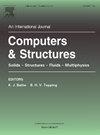Multi-scale concurrent topology optimization of lattice structures with single type of composite micro-structure subjected to design-dependent self-weight loads
IF 4.4
2区 工程技术
Q1 COMPUTER SCIENCE, INTERDISCIPLINARY APPLICATIONS
引用次数: 0
Abstract
This paper presents a computational framework for compliance-based multi-scale concurrent topology optimization including self-weight. The macro-scale structure consists of periodically arranged composite micro-structures, such that the representative unit cell of each micro-structure is composed of multiple base-materials, instead of single base-material as usually encountered in the literature. The effective elastic tensor of the micro-structure is evaluated using the strain energy method (SEM), which is incorporated with a mapping based interpolation scheme for multiple underlying materials. Sensitivity analysis is executed in both macro-scale and micro-scale, providing the gradient information for updating the design variables using the method of moving asymptotes (MMA). The undesirable phenomena related to the design-dependent self-weight load are observed, including the parasitic effect and the inactive volume constraint. When the self-weight load is dominant over the external fixed loads, especially in the case of pure self-weight, the optimizer tends to remove material to reduce self-weight, and thus reduces the structural compliance. This phenomenon, which is referred as inactive volume constraint in the literature, occurs at both scales. On the other hand, the parasitic effect, which is the appearance of erratic intermediate density patterns, occurs only in the macro-structure but not in the micro-structure. Discussion on possible treatments for these numerical issues is provided. Several numerical examples of 2D structures are examined to demonstrate the feasibility and performance of the developed method.
设计依赖自重载荷作用下单型复合材料微结构点阵结构的多尺度并行拓扑优化
本文提出了一种基于顺应性的多尺度并发拓扑优化(包括自重)计算框架。宏观尺度结构由周期性排列的复合微结构组成,每个微结构的代表单元由多种基体材料组成,而不是文献中常见的单一基体材料。微结构的有效弹性张量采用应变能方法(SEM)进行评估,该方法结合了基于映射的多基础材料插值方案。在宏观和微观尺度上都进行了敏感性分析,为使用移动渐近线方法(MMA)更新设计变量提供了梯度信息。观察到了与设计相关的自重载荷有关的不良现象,包括寄生效应和非活动体积约束。当自重载荷大于外部固定载荷时,尤其是在纯自重情况下,优化器倾向于去除材料以减轻自重,从而降低结构顺应性。这种现象在文献中被称为非活动体积约束,在两种尺度上都会出现。另一方面,寄生效应,即出现不稳定的中间密度模式,只出现在宏观结构中,而不出现在微观结构中。本文讨论了这些数值问题的可能处理方法。研究了几个二维结构的数值示例,以证明所开发方法的可行性和性能。
本文章由计算机程序翻译,如有差异,请以英文原文为准。
求助全文
约1分钟内获得全文
求助全文
来源期刊

Computers & Structures
工程技术-工程:土木
CiteScore
8.80
自引率
6.40%
发文量
122
审稿时长
33 days
期刊介绍:
Computers & Structures publishes advances in the development and use of computational methods for the solution of problems in engineering and the sciences. The range of appropriate contributions is wide, and includes papers on establishing appropriate mathematical models and their numerical solution in all areas of mechanics. The journal also includes articles that present a substantial review of a field in the topics of the journal.
 求助内容:
求助内容: 应助结果提醒方式:
应助结果提醒方式:


